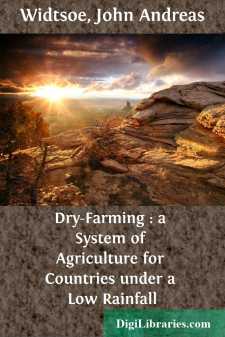Categories
- Antiques & Collectibles 13
- Architecture 36
- Art 48
- Bibles 22
- Biography & Autobiography 813
- Body, Mind & Spirit 142
- Business & Economics 28
- Children's Books 15
- Children's Fiction 12
- Computers 4
- Cooking 94
- Crafts & Hobbies 4
- Drama 346
- Education 46
- Family & Relationships 57
- Fiction 11828
- Games 19
- Gardening 17
- Health & Fitness 34
- History 1377
- House & Home 1
- Humor 147
- Juvenile Fiction 1873
- Juvenile Nonfiction 202
- Language Arts & Disciplines 88
- Law 16
- Literary Collections 686
- Literary Criticism 179
- Mathematics 13
- Medical 41
- Music 40
- Nature 179
- Non-Classifiable 1768
- Performing Arts 7
- Periodicals 1453
- Philosophy 64
- Photography 2
- Poetry 896
- Political Science 203
- Psychology 42
- Reference 154
- Religion 513
- Science 126
- Self-Help 84
- Social Science 81
- Sports & Recreation 34
- Study Aids 3
- Technology & Engineering 59
- Transportation 23
- Travel 463
- True Crime 29
Dry-Farming : a System of Agriculture for Countries under a Low Rainfall
Categories:
Description:
Excerpt
CHAPTER I
INTRODUCTION
DRY-FARMING DEFINED
Dry-farming, as at present understood, is the profitable production of useful crops, without irrigation, on lands that receive annually a rainfall of 20 inches or less. In districts of torrential rains, high winds, unfavorable distribution of the rainfall, or other water-dissipating factors, the term "dry-farming" is also properly applied to farming without irrigation under an annual precipitation of 25 or even 30 inches. There is no sharp demarcation between dry-and humid-farming.
When the annual precipitation is under 20 inches, the methods of dry-farming are usually indispensable. When it is over 30 inches, the methods of humid-farming are employed; in places where the annual precipitation is between 20 and 30 inches, the methods to be used depend chiefly on local conditions affecting the conservation of soil moisture. Dry-farming, however, always implies farming under a comparatively small annual rainfall.
The term "dry-farming" is, of course, a misnomer. In reality it is farming under drier conditions than those prevailing in the countries in which scientific agriculture originated. Many suggestions for a better name have been made. "Scientific agriculture" has-been proposed, but all agriculture should be scientific, and agriculture without irrigation in an arid country has no right to lay sole claim to so general a title. "Dry-land agriculture," which has also been suggested, is no improvement over "dry-farming," as it is longer and also carries with it the idea of dryness. Instead of the name "dry-farming" it would, perhaps, be better to use the names, "arid-farming." "semiarid-farming," "humid-farming," and "irrigation-farming," according to the climatic conditions prevailing in various parts of the world. However, at the present time the name "dry-farming" is in such general use that it would seem unwise to suggest any change. It should be used with the distinct understanding that as far as the word "dry" is concerned it is a misnomer. When the two words are hyphenated, however, a compound technical term—"dry-farming"—is secured which has a meaning of its own, such as we have just defined it to be; and "dry-farming," therefore, becomes an addition to the lexicon.
Dry-versus humid-farming
Dry-farming, as a distinct branch of agriculture, has for its purpose the reclamation, for the use of man, of the vast unirrigable "desert" or "semi-desert" areas of the world, which until recently were considered hopelessly barren. The great underlying principles of agriculture are the same the world over, yet the emphasis to be placed on the different agricultural theories and practices must be shifted in accordance with regional conditions. The agricultural problem of first importance in humid regions is the maintenance of soil fertility; and since modern agriculture was developed almost wholly under humid conditions, the system of scientific agriculture has for its central idea the maintenance of soil fertility. In arid regions, on the other hand, the conservation of the natural water precipitation for crop production is the important problem; and a new system of agriculture must therefore be constructed, on the basis of the old principles, but with the conservation of the natural precipitation as the central idea....


